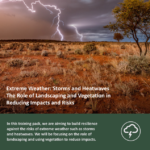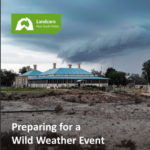Nature-Based Solutions to Combat Storms and Heatwaves
Nature-based solutions give landholders powerful ways to prepare for storms and heatwaves by using natural ecosystems to reduce their impact. By working with natural systems, these solutions not only help lessen the effects of extreme weather but also boost biodiversity and make the land more resilient.
Increase in Extreme weather and the role of Climate Change
Climate change, driven by human activities, is leading to more frequent and severe extreme weather events. According to The Intergovernmental Panel on Climate Change, (an intergovernmental body of the United Nations), an increase of a 1.1-degree has impacted us through the increased frequency and magnitude of extreme weather events from heatwaves, droughts, flooding, winter storms, cyclones and bushfires.
Extreme weather in Australia refers to unusual and severe weather conditions that are much more intense than the typical weather for the region and time of year. This can include intense thunderstorms, cyclones, bushfires, heatwaves, droughts, floods, and severe cold spells. These events often come with strong winds, heavy rainfall, high temperatures, or rapid temperature drops, causing significant impacts on the environment, people’s health, and infrastructure. Climate change is believed to be making these extreme weather events more frequent and intense.
Problems/Impacts caused by Storms and Extreme Weather
Climate change and the resulting extreme weather poses significant challenges to Landcare activities in NSW. These challenges arise due to the increased frequency and intensity of storms and heatwaves, which impact various aspects of land management and restoration. Here are some detailed challenges:
Soil Erosion and Degradation
- Storms: Heavy rainfall and strong winds from storms can cause significant soil erosion, washing away nutrient-rich topsoil and degrading land quality.
- Heatwaves: Prolonged heatwaves dry out soil, reducing its moisture content and making it more prone to erosion. Dry, cracked soil also loses its ability to support plant growth effectively.
Water Management Issues
- Flooding: Intense storms can lead to flooding. Floodwaters can erode riverbanks, spread pollutants, and disrupt the natural hydrology of the area.
- Drought and Scarcity: Heatwaves increase evaporation rates and water demand, leading to water scarcity. Managing limited water resources becomes a critical challenge, affecting irrigation and the health of natural ecosystems.
Vegetation Damage and Loss
- Wind Damage: Strong winds during storms can uproot trees, damage plants, and destroy newly planted vegetation. This setback requires significant replanting and restoration efforts.
- Heat Stress: Extreme heat can cause heat stress in plants, leading to reduced growth, increased susceptibility to pests and diseases, and higher mortality rates. Heatwaves can also exacerbate the effects of drought.
Risk Assessment and Planning
It is essential to identify high-risk areas and develop thorough plans for mitigating risks when preparing for extreme weather events on your property.
Downloadable wild weather training pack and worksheet


Extreme Weather: Storms and Heatwaves The Role of Landscaping and Vegetation in Reducing Impacts and Risks
In this training pack, we are aiming to build resilience against the risks of extreme weather such as storms and heatwaves. We will be focusing on the role of landscaping and using vegetation to reduce impacts.
Download: Wild Weather Training Pack
Preparing for a Wild Weather Event Worksheet
After learning about the risks of extreme storms and weather, take proactive steps to safeguard your property.
Download: Wild Weather Worksheet
Wild Weather Videos
Explore the science behind Earth’s wild weather patterns and how they shape our climate. In this video, we break down the key drivers of weather systems, such as the El Niño-Southern Oscillation, the Indian Ocean Dipole, and the Southern Annular Mode. Discover how these natural forces influence rainfall, temperature, and wind patterns, both locally and globally. Understanding these phenomena is crucial for decision-making in land care, farming, and biodiversity restoration projects. Learn how natural disasters like floods, droughts, and storms are linked to these climate systems and what strategies can be implemented to mitigate their impacts.
Other Disaster Resources
Helpful Resources
Facts about Climate Change:
Facts about the climate emergency – United Nations Environmental Program
How will climate change affect Australia? – Climate Council of Australia
Earth Systems and Climate Change Hub – National Environmental Science Program
Australia’s Changing Climate – CSIRO
storms and extreme weather
Increasing frequency and intensity of extreme weather events
Fencing, Land Works & Healthy Soil
Stock & Waterways – Riparian Fencing
Bellinger Landcare – The Bellinger River system Landholder Booklet
Soil Conservation Service – Post flood Riparian Rehabilitation on the Tweed River
Risk Frontiers – Nature-based Flood Mitigation Strategies
Local Land Service – What is a Healthy Soil?
Shoalhaven Riverwatch – Sand Sausages on the Shoalhaven River